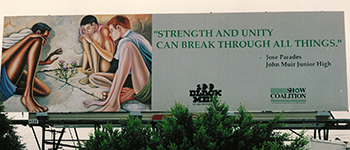15 July 1938 – 27 Apr. 2009
Ernest Eugene Barnes – known as Ernie -- was born on July 15, 1938 to parents Ernest E. Barnes, Sr. and Fannie Mae Geer near the Hayti neighborhood in Durham. His father, originally from Oxford, was a clerk at Liggett Myers and his mother was a domestic worker in the home of Durham lawyer Frank L. Fuller, Jr.

Barnes described himself as an overweight and non-athletic child who was bullied by other children. He was allowed to read art books at the home of Fuller and began to carry around a sketchbook in elementary school, putting his energy into art as an antidote to bullying. He received support from a teacher who also coached the school wrestling team, and he began to apply himself to sports in high school. He was captain of the football team at Durham’s then segregated Hillside High School for his senior year. He graduated in 1956.
Reaching an adult height of 6 feet 3 inches, Barnes earned an athletic scholarship to North Carolina Central University (then the North Carolina College at Durham) and majored in art. He left the school in 1959 with his degree unfinished to be drafted into professional football as an offensive lineman in the American Football League. It was a long career as an artist that would ultimately define his legacy.
He played football from 1959 to 1965, drafted first by the Baltimore Colts. In 1960 he moved to the New York Titans for a season, followed by the San Diego Chargers for a few years, the Denver Broncos. He finished his career in the Canadian league for the Saskatchewan Roughriders.
Nicknamed "Big Rembrandt", Barnes reportedly kept a sketch book with him during games, taking free moments to sketch players. He painted a number of paintings during his football career that were produced by immediate inspiration from the game, including “The Bench” which was donated by his wife to the Professional Football Hall of Fame in 2014. These paintings were inspired by the intense physical and emotional experience of violence inherent in the sport.
Following Barnes’ retirement from football, his career as an artist took off. Inspired by his own experience and heritage as an African American, Barnes work was evocative and sculptural, as he fused elongated sculptural forms of the human body, vibrant color, movement and emotional energy. He often painted his figures with their eyes closed. He painted canvasses that appeared on the television show “Good Times” as the work of the show’s character “JJ”. One of his most famous works, “The Sugar Shack”, a meditation on his childhood experience of the collision of innocence with the passion of dance, appeared in the credits beginning in the fourth season.
“The Sugar Shack” later became the cover image for Marvin Gaye’s album “I Want You," and his paintings illustrated the covers of several other albums. Barnes exhibited his work in a solo show at the North Carolina Museum of Art in 1979, produced posters for the 1984 Olympics in Los Angeles, and had his work exhibited in numerous venues.
Barnes also communicated social themes and tragedy in his art. Following the 9-11 terrorist attacks, he painted “In Remembrance”. Another painting, “Growth Through Limits”, was reproduced on a billboard designed to reach inner-city youth following the Los Angeles riots of 1992.
He also appeared on a number of television programs, including episodes of "Good Times" and the game show "To Tell the Truth". He is credited with co-creating a celebrity variety special in 1971 called "Super Comedy Bowl" that starred athletes, actors, and comedians. He also appeared in a number of films and authored a number of books, including two autiobiographies. He was inducted into the National Black College Alumni Hall of Fame Foundation for his contribution to the arts.
Ernie Barnes passed away in Los Angeles on August 27, 2009 from a blood cancer. He was married three times and had five children.